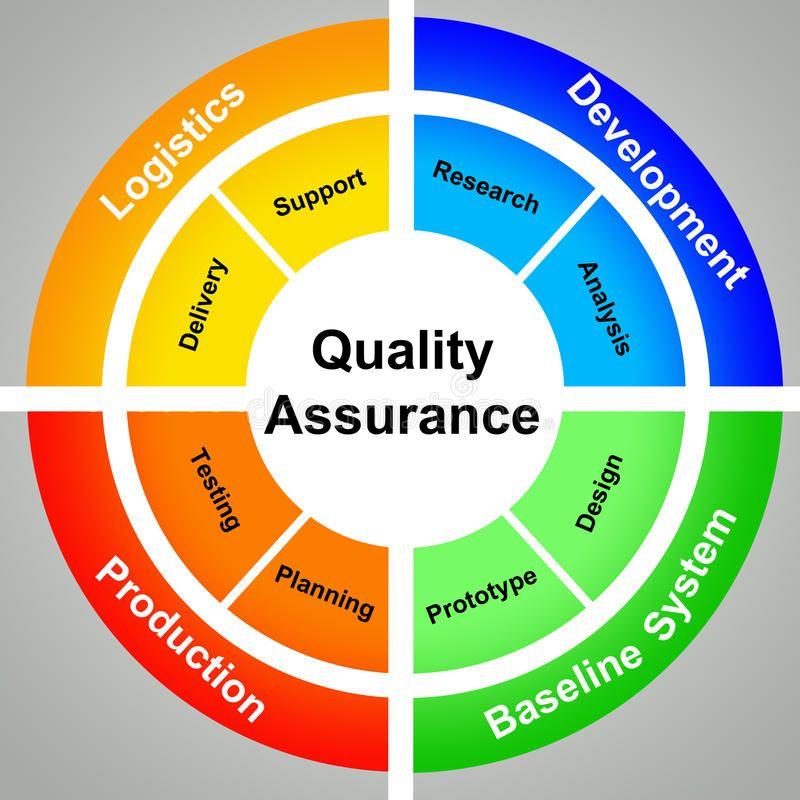
Quality Assurance has always been a center point of product quality and team efficiency throughout our software development experience. A good testing process ensures continuous development, creativity, and product enhancement.
Quality assurance (QA) and software Automation testing are integral to software development but can also be monotonous, laborious, and ineffective if not well organized. What are the creative ways you can enhance your QA planning to make it more agile, effective, and creative? To help you improve your QA process and deliver a better product, here are some tips and ideas.
Table of Contents
What is a QA Process?
To us, QA is a paramount step in the software life cycle. QA engineers work with a product from the very beginning, as soon as it goes through the planning and ideas phase, right up to the very end.
This is why QA management becomes the basis for the entire project management. As other software development directors strive to develop a superior product, QA ensures that the testing process flow is equally superior.
Quality Assurance provides for the development of lasting innovations, everyone’s participation, and the continuous detection of optimization areas. That is why the first action that we take in the course of QA optimization is making tangible process improvements.
Here are a few of them to start with:
-
Planning and Documentation
The first step is to analyze the status of your current QA plan. It should entail the strengths, weaknesses, opportunities, and threats of your current SWOT. The basis for cost and time estimation, communication, and project deliverables should be firm among the team. During the course of the project, it is easy to forget priorities, deliverables, and user needs.
A SWOT analysis tool or a simple matrix can help you map out the internal and external forces that influence QA performance. Some questions to ask yourself are: What are the aims and objectives of your QA plan? What is the way of measuring and reporting your QA results? What practices and standards do you use and how? What are the difficulties and dangers you are confronted with? What is your approach to communicating and working with your stakeholders?
-
Taking User Acceptance into Account
The second way to improve the innovation of your QA planning is to take a user-centric approach that targets the needs, expectations, and expectations of your end users. A crucial mistake that many teams make is to depend solely on internal team resources for giving feedback. The testing methods do not include users, and team members might not know how the actual end customer will interact with the product.
There are a variety of tools and techniques you can apply to help you understand your users, which include personas, user stories, scenarios, surveys, interviews, usability testing, and analytics. In this case, a user-focused quality assurance plan involves incorporating user insights in order to ensure that the product meets the user requirements, solves user problems, and adds value. You can also involve user feedback to support your QA findings and identify issues, prioritizing improvements.
Before QA teams declare product responsiveness to software testing strategies, user acceptance testing should be used. Monitoring use patterns, hosting a session (physical or via Skype), and so on. First of all, it is crucial to go through the most frequently applied ways of user acceptance tests.
- Alpha and beta-testing: users are taken to the development environment, and their input is received in real-time.
- Contract Acceptance testing: The product owners and stakeholders perform the user function by reviewing the product and confirming its compliance with the requirements.
- Regulation testing: compliance with governmental laws and regulations constitutes the main evaluation criterion.
- Production readiness testing: users and teams verify secondary test process improvement – backup, security, log-out, account deletion, etc.
- Black box testing: developers, QA engineers, and users look at the code without actually seeing the source code. QA testers can be unbiased and see how optional consumers find apps’ flaws as if they were black-box testing.
-
Utilize Artificial Intelligence and Automation
The third step to innovating your QA planning focuses on embracing automation, coupled with AI, in order to increase your QA efficiency, accuracy, and speed. Automation and AI can be used for a number of QA activities that include test case creation, execution, detecting defects, classifying defects, resolving defects, and preventing defects. Using automation and AI will help you eliminate the possibility of making human errors, save on resources and time, improve the quality and reliability of results, optimize testing workflows, and more. For instance, consider integrating cloud-based testing platforms like LambdaTest, which offers a scalable and agile solution for cross-browser and cross-device testing. LambdaTest provides access to 3000+ of real browsers OS including real device cloud, speeding up testing cycles and enhancing testing coverage. Nonetheless, automation and AI are no replacements for human judgment and creativity, hence the need for manual testing and human input.
-
Try New QA Methods and Techniques.
Fourth, experiment with new QA methods and techniques to improve QA agility and creativity. You can consider various QA approaches, which range from exploratory testing, risk-based testing, behavior-driven testing, test-driven development, and shift-left testing. You can also test new QA ideas such as pairwise testing, boundary value analysis, equivalence partitioning, state transition testing, and mutation testing. It is advisable to experiment with new QA methods and techniques. Through this, you may discover new ways to test your products, identify more defects, and learn new things about the product.
-
Learn From Others, and Also Share Your Knowledge.
It means that you should be willing to learn from others and share your knowledge with peers, colleagues, and the community. There are various QA materials you can read, like blogs, books, articles, podcasts, webinars, and case studies. You can also be part of the online forums, groups, networks, and events where you can meet QA professionals, experts, and enthusiasts. Write blogs, articles, podcasts, webinars, and case studies on your QA experiences, insights, and best practices that you can share your knowledge with. Additionally, you can take part in Quality Assurance (QA) discussions, answer questions, and provide feedback through online forums, groups, networks, and events.
-
Cooperating With Developers More
Nowadays, QA teams work in tandem with developers in an iterative manner. Once the functionality has been written, the Quality Assurance & Testing group is given it. In contrast, good QA teams operate with a preventive rather than a reactive approach. Rather than addressing problems at later development stages, they monitor the development process and catch quality issues at the production stage.
- Sharing documentation: shared files and reports should be accessible to the developers and QA engineers.
- Transparent metrics: all documents related to areas of improvement for software engineers should be data-driven and easily measured.
- Joint meetups: QA and developer teams should meet at least once or twice a week.
- Responsibility: while technically they collaborate, developers and QA specialists should be responsible for delivering specific metrics.
However, when QA methodologies and best practices enter into the development process, the product quality cannot be solely placed on their shoulders. Developers should be responsible for particular results.
Two important strategies that project managers can employ to merge QA and developers are pair development and test-driven software engineering. Test-driven development implies that engineers rely on reports, supplied by a quality team, instead of using a standard method.
Code editors are involved in pair development, which involves working in real time between the developers and the QA engineers. The QA specialists keep track of improvements and best practices and can identify what processes need to be improved and provide specific recommendations.
-
Technical Reviews
And, as always, we know the importance of developers being held accountable for certain development assignments. Therefore, formal technical reviews should also be conducted using the same system. FTR is a meeting during which QA teams compare the end code and the initial requirements.
The FTRs are conducted on established products. QA makes sure that the results of developers correspond with the existing standards while reporting results. Every review includes summarizing the reports with a score, the responsible people (for the review), and a list of the decisions made.
There are two types of formal reviews: a walkthrough and an inspection. A walkthrough is an actual step-by-step examination of source code and documentation in order to reveal bugs. The other functionality and non-functional requirements are verified in the inspection.
-
Periodically review and revise your QA plan.
The last step in your innovative QA planning is to regularly review and improve your QA plan after considering QA results, user feedback, and learning outcomes. For QA plan review and improvement, you may resort to retrospectives, audits, reviews, surveys, metrics, and dashboards. Regularly reviewing and improving your QA plan will ensure that your QA plan aligns with your product goals, user needs, and business objectives. In addition, this allows you to point out gaps, problems, and opportunities for improvement and take the necessary measures.
Conclusion
Finally, the quest for enhancing QA planning in software development is a never-ending mission that requires a positive mindset, eagerness, and an open mind to change. Through strategic planning and documenting, user-centric perspectives, automation and AI, experimentation using new methodologies, knowledge sharing, technical review, and plan renewals, teams can significantly increase the QA efficiency levels.
That is why such innovative practices should be accepted to ensure that the development cycle is achieved without any hiccups. It also improves the quality of the product and user satisfaction, hence total business success. Continuous improvement and learning enable organizations to match with technological advancement and provide products that exceed user’s expectations.
Thus, innovative QA planning is a must for this fast-evolving digital era. The introduction of these revolutionary methods can enable teams to pass the complexities in the software development process without any hiccups, leading to the development of quality, durable, and user-oriented products that are built to last.
Additionally, your QA planning could involve using cloud-hosted testing platforms such as LambdaTest. LambdaTest makes it easy for your web application to work correctly in many different environments. Including LambdaTest into your QA processes allows for testing on a variety of real browsers and devices, thereby reducing testing cycles and increasing testing coverage. The process will be faster, the issues will be identified in the shortest time possible, and better quality products will be produced.









